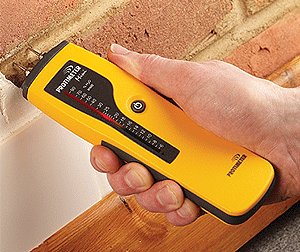How to use a Protimeter Mini
The Protimeter Mini moisture meter has been the choice for thousands of users across the world for more than 30 years. The enduring popularity and success of these instruments is attributable to a simple, versatile design, robust construction and ease of use.
Commonly utilised by building surveyors for checking the moisture in building structures, the Protimeter Mini can measure both the surface and sub-surface moisture. Featuring two-pins at the top of the instrument for reading surface readings, whilst deep wall probes can be utilised to measure the sub-surface readings.
Utilising the Protimeter Mini
Surface Readings – Two-pin method
Sub-Surface Readings – Deep wall probe method
Determining the readings
Measuring Moisture in Walls
Measuring Moisture Around doors and windows
Measuring Moisture in Floors
Measuring Moisture in wood
Utilising the Protimeter Mini
The Protimeter Mini moisture meter is a very simple instrument to utilise with the two-pins located at the top of the main body. Depending upon the reading, one of the LEDs will detail the severity of the moisture reading, refer to Determining the Readings.

Simply hold the instrument with the pins touching the material’s surface and read the moisture level from the LED scale.
A low or no reading will occur if the pins are placed onto a painted or varnished surface. Similarly a covering like vinyl will not hold moisture and provide a low reading.
Be careful not to push the pins into a surface which can be damaged or marked.

When determining the sub-surface moisture readings, the surveyors can utilise a set of deep wall probes which connect to the Protimeter Mini through the external auxiliary port.
To use the Deep Wall Probe, drill two clearance holes 1/4 in. (6 mm) in diameter and approximately 1 1/2 in. (40 mm) apart to the required depth.
Connect the Deep Wall Probes to the instrument and push the two probe rods into the clearance holes.
Determining the readings
Moisture readings are displayed through a collection of 60 LEDs divided into colour-coded zones, signifying the severity of the moisture reading. The readings are supported with a scale printed to the right of the LEDs.
Depending upon the moisture reading, one of the LEDs will light up to allow the surveyor to read the moisture reading. The scale runs from 6% to 90% WMC (wood moisture content). The WME value is the theoretical moisture level that would be attained by wood that is in moisture equilibrium with the material being tested.
The LEDs are subdivided into three colour zones, green, yellow, and red indicating the severity of the moisture reading. In most cases it is quicker and easier to determine the reading using the colour.
• In the green zone, moisture levels are in a safe air-dry condition
• In the yellow zone, moisture levels are higher than normal but not critical; further investigation is recommended
• In the red zone, moisture levels are excessive and too high. If sustained, high moisture levels will lead to decay
Measuring Moisture in Walls
Utilise the two-pin method to read the surface moisture levels. Start measuring at waist height and work downwards to the floor. If a high reading is encountered, utilise a set of deep wall probes to access the internal structure.
Measuring Moisture Around doors and windows
Place the pins into the wall next to the door or window frame. If a high reading is encountered, move outwards until the reading stabilises. As this is an opening, often a higher reading will be encountered.
Measuring Moisture in Floors
Normally the surface reading will be drier than the subsurface. If permitted, it is recommended to support the reading with subsurface readings using deep walls probes or utilises a Protimeter Hygromaster for %RH readings.
Measuring Moisture in wood
In a dry environment where the wood has had time to dry out, place the two pins into the wood and take a reading. Often it may be advisable to use a hammer electrode so deeper readings can be taken.
